Why is protest essential in a democracy?
The First Amendment guarantees freedoms concerning religion, expression (free speech and free press), assembly and the right to petition. It forbids Congress from both promoting one religion over others and also restricting an individual's religious practices. It guarantees freedom of expression by prohibiting Congress from restricting the press or the rights of individuals to speak freely. It also guarantees the right of citizens to assemble peaceably and to petition their government.
Defining Rights in the American Colonies
The rights of private citizens were very important to those who had just fought the British and won independence for the American colonies. Their experience with the British king and Parliament had made them wary of creating a new government that was determined to protect the rights of the individual against authority. When the original version of the proposed Constitution for the United States was drafted, opponents challenged its silence on individual protections.
In response, the Bill of Rights was added as the first 10 amendments to the Constitution. The very first one prohibited the federal government from restricting the right of the individual to protest government policy or to express personal opinions. It reads:
"Congress shall make no law respecting an establishment of religion, or prohibiting the free exercise thereof; or abridging the freedom of speech, or of the press; or the right of the people peaceably to assemble, and to petition the Government for a redress of grievances."
Whether one favors or opposes an issue, the federal government does not have the authority to silence free expression. This is the bedrock on which the right of protest rests. Originally, the First Amendment applied only to the federal government, not the states, but later amendments and court cases have generally stretched it to apply to the states as well.
The right of expression is essential in a democracy. Without it, a government could adopt any policy and prevent the public from objecting or even discussing it in public. Anyone has the right to try to get others to align with his/her viewpoint and to create a majority that can change the law.
Protests and Democracy
Protest movements have been part of American history from the very beginning. Many important reforms in American life have originated as protests against established practices. The abolition of slavery and restricts on the sale of alcohol (temperance) stirred national debate and resulted in major changes. Freedom of the press to investigate and to publish information — and opinions — is essential to this process.
In recent times, with revolutionary expansions in communications and access to media, students have found their voice in shaping policy. Petitions and rallies in schools draw attention to issues important to students. Colleges were the scene of intense protest in the 1960s against the draft and the Vietnam War. In light of recent school shootings, student groups have organized to press for more restrictive gun laws. In 1965, five Des Moines students, including John and Mary Beth Tinker and Chris Eckhardt, wore black armbands to school to protest America's involvement in the Vietnam War. School officials sent them home and did not allow them to return wearing the protest symbols. They claimed that the armbands were disruptive. A lawsuit challenging the decision went all the way to the U.S. Supreme Court which ruled in favor of the students.
In 1969, the Court ruled in favor of the students and affirmed the right of students to protest. The arm bands were protected by the First Amendment right of free speech. In a 7-2 decision in Tinker v. Des Moines, the Court ruled that students do not "shed their constitutional rights to freedom of speech or expression at the schoolhouse gate."
Supporting Questions
Why do people protest?
- Memo from Lee White to President Lyndon B. Johnson to Prepare for a Meeting with Martin Luther King, Jr., March 4, 1965 (Document)
- Excerpts from Tinker v. Des Moines U.S. Supreme Court Majority Opinion, 1968 (Document)
- "New Indian" (American Indian Movement), 1977 (Video)
How have protests sought to protect individuals rights to “just” working conditions?
- Demonstration of Protest and Mourning for Triangle Shirtwaist Factory Fire Victims, April 5, 1911 (Image)
- Farmers Strike in Sioux City, Iowa, 1932 (Image)
- Letter from A. Philip Randolph to New York City Mayor Fiorello La Guardia, June 5, 1941 (Document)
- Flyer Distributed to Striking Sanitation Workers in Memphis, Tennessee, 1968 (Document)
- News Release from Muscatine Community Effort Organization about H. J. Heinz Company Boycott, 1969 (Document)
- Letter from Harvey Milk to President Jimmy Carter about Briggs Initiative, June 28, 1978 (Document)
How have those in power responded to protests?
- Iowa National Guard Members on Duty during the "Iowa Cow Wars," September 25, 1931 (Image)
- Correspondence between President Harry S. Truman and NAACP Acting Secretary Roy Wilkins, October 10-November 8, 1949 (Document)
- "D.M. Schools Ban Wearing of Viet Truce Armbands" Newspaper Article, December 15, 1965 (Document)
- Memo Sent to President Richard Nixon's Administration "Regarding Major Issues with the Wounded Knee Occupation," May 9, 1973 (Document)
- "The Great Depression: Strike Turns Violent" from Iowa Public Television, 1979 (Video)
- Iowa Commission on Native American Affairs Letter of Concerns about Dakota Access Pipeline, April 28, 2016 (Document)
How has involvement in protests swayed public opinion?
- Children's Crusade for Amnesty, 1922 (Image)
- Youth March of Integrated Schools in Washington, D.C., October 25, 1958 (Image)
- Protest Plans Submitted into Evidence during Landmark Tinker v. Des Moines Supreme Court Case, December 1965 (Document)
- "Stories from Selma: Rev. Gwendolyn C. Webb," March 2015 (Audio)
| Protest in America Teaching Guide |
| Printable Image and Document Guide |
Memo from Lee White to President Lyndon B. Johnson to Prepare for a Meeting with Martin Luther King, Jr., March 4, 1965

Description
The memo features detailed notes for a meeting that was to occur between President Lyndon B. Johnson and Dr. Martin Luther King, Jr. The document was dated just three days before the first march in Selma, Alabama. Clearly from the notes, voting rights was the focus of the…
Excerpts from Tinker v. Des Moines U.S. Supreme Court Majority Opinion, 1968
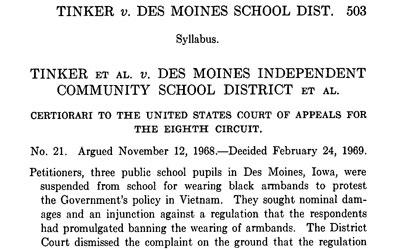
Description
The following document features excerpts from the landmark 1969 Tinker v. Des Moines Independent Community School District decision by the U.S. Supreme Court. The opinion was written by Justice Abe Fortas, and it established a precedent about protected speech in…
"New Indian" (American Indian Movement), 1977
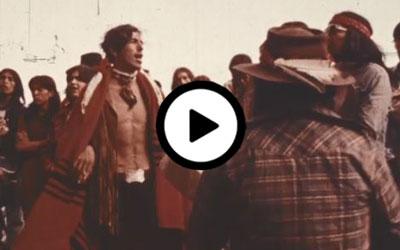
Description
The American Indian Movement (AIM) began on July 11, 1968, in Minnesota to combat police brutality. Later AIM evolved into a goal of uniting all indigenous people to uplift communities, pride and sovereignty. A major protest for the organization came in 1972 with the Trail…
Demonstration of Protest and Mourning for Triangle Shirtwaist Factory Fire Victims, April 5, 1911
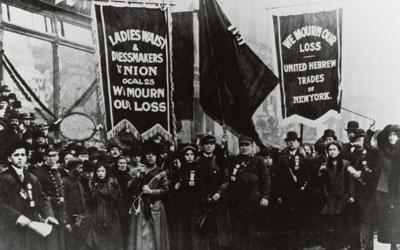
Description
The fire at the Triangle Waist Company was the deadliest workplace disaster in the history of New York, causing the deaths of 123 women and 23 men. This tragedy was used as a rallying cry to change unjust labor practices, such as the locking exits to minimize breaks for…
Farmers Strike in Sioux City, Iowa, 1932
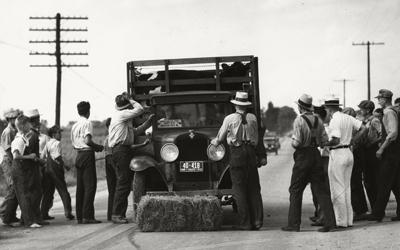
Description
The roadblock depicted in the image shows a tactic used during the Farmers' Holiday Strike of 1932. The strike was called for after the National Farmers’ Union, who had been lobbying for years to gain aid and tariff reform to help with the falling prices for goods during the…
Letter from A. Philip Randolph to New York City Mayor Fiorello La Guardia, June 5, 1941
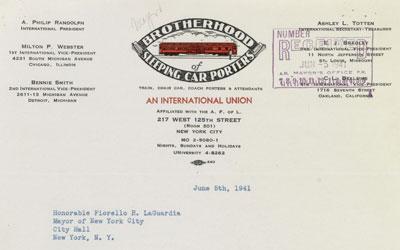
Description
Frustrated by the lack of job opportunities for African Americans in defense industries and by racial segregation in the military, labor leader and civil rights advocate A. Philip Randolph wrote to New York City Mayor Fiorello LaGuardia asking for his support. In…
Flyer Distributed to Striking Sanitation Workers in Memphis, Tennessee, 1968
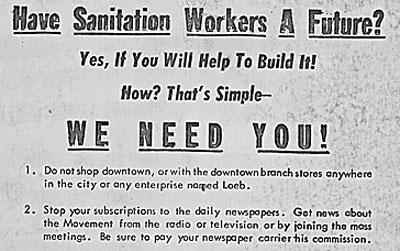
Description
This flyer was distributed to the striking sanitation workers in Memphis, Tennessee, requesting volunteer assistance and offering instructions for sanitation workers and their sympathizers. The first attempted strike failed to lead to better working conditions or pay…
News Release from Muscatine Community Effort Organization about H. J. Heinz Company Boycott, 1969
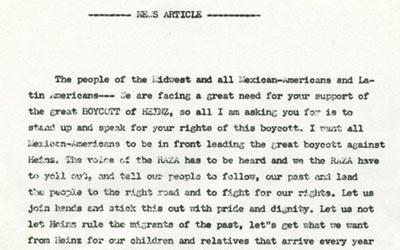
Description
Activists from the 150-member Muscatine Community Effort Organization (CEO) worked to expose poor working and living conditions for migrant workers and their children in the Muscatine area. Activists from CEO joined forces with the League of United Latin American…
Letter from Harvey Milk to President Jimmy Carter about Briggs Initiative, June 28, 1978
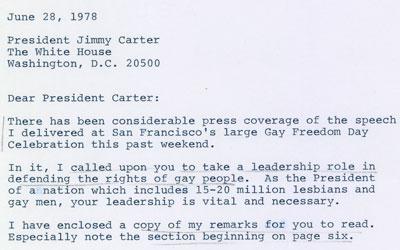
Description
In this June 1978 letter, Harvey Milk, the first openly-gay person to be elected into public office in California, petitioned President Jimmy Carter to lend his support in defeating Proposition 6, also known as the Briggs Initiative. Elected to the San Francisco Board of…
Iowa National Guard Members on Duty during the "Iowa Cow Wars," September 25, 1931
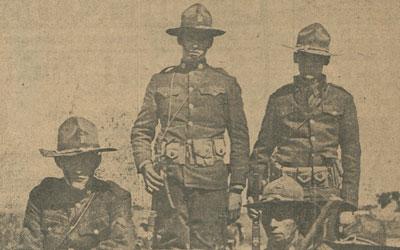
Description
The "Iowa Cow Wars" was a protest undertaken by farmers mainly in Cedar County against tuberculosis (TB) tests on cattle administered by veterinarians under Iowa law in 1931. TB-testing was done in an effort to eradicate TB because of the public health risk from…
Correspondence between President Harry S. Truman and NAACP Acting Secretary Roy Wilkins, October 10-November 8, 1949
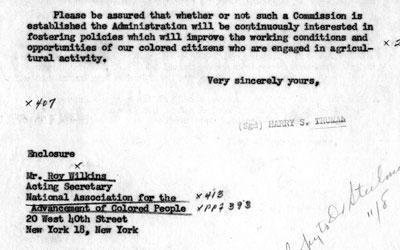
Description
President Harry S. Truman wrote to activist Roy Wilkins to recommend establishing a Presidential Commission of Agricultural Problems as a reaction to problems developing with migratory workers from Mexico. Roy Wilkins was at the time of this letter a leader of the National…
"D.M. Schools Ban Wearing of Viet Truce Armbands" Newspaper Article, December 15, 1965
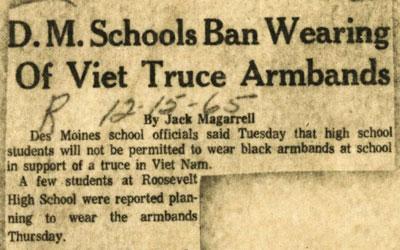
Description
This article from The Des Moines Register was entered as defendants' Exhibit 2 in John F. Tinker et. al. v. The Des Moines Independent Community School District et. al. It describes the decision of Des Moines, Iowa, school officials to ban students from…
Memo Sent to President Richard Nixon's Administration "Regarding Major Issues with the Wounded Knee Occupation," May 9, 1973
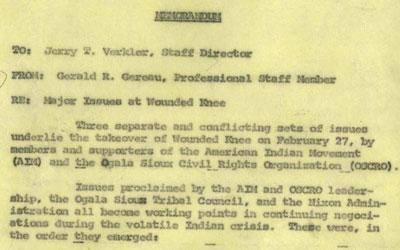
Description
This memo details separate and conflicting sets of issues in regard to the American Indian Movement (AIM) and Oglala Sioux Civil Rights Organization (OSCRO) occupation of Wounded Knee, South Dakota (on Pine Ridge Reservation). Wounded Knee was the site of an infamous…
"The Great Depression: Strike Turns Violent" from Iowa Public Television, 1979
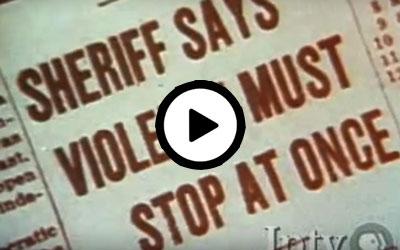
Description
The video from Iowa Public Television shows two opposite perspectives on the farmers strike in the early 1930s when tensions erupted into violence. On one side was Harold Ewing, a striking farmer, and the other side was then Plymouth County Sheriff Ralph Rippey. Prior to the…
Iowa Commission on Native American Affairs Letter of Concerns about Dakota Access Pipeline, April 28, 2016
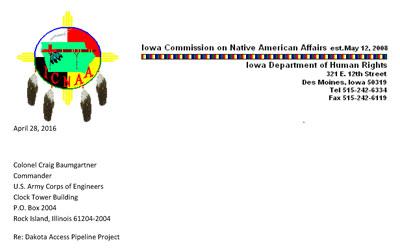
Description
The letter below was sent to the Army Corps of Engineers by the Iowa Commission on Native American Affairs in response to a then-proposed, now-completed Dakota Access Pipeline (DAPL) that sends oil from northwest North Dakota to Illinois crossing…
Children's Crusade for Amnesty, 1922
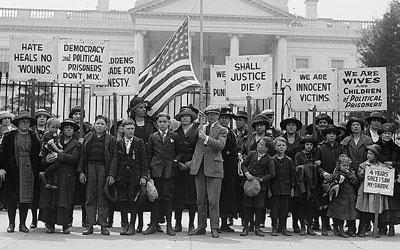
Description
Following World War I, protests by women and children of political prisoners sought to increase awareness of the plight of men jailed in violation of the Espionage Act during the war with support from the Americal Civil Liberties Union (ACLU). The protest itself was lead by…
Youth March of Integrated Schools in Washington, D.C., October 25, 1958
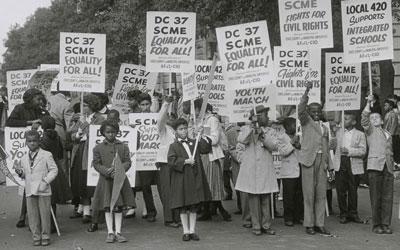
Description
This photograph, taken October 25, 1958, depicts the first of two marches in Washington, D.C., with the goal of highlighting the efforts to end racially-segregated schools four years after the landmark Brown v. Board of Education Supreme Court decision. In August 1958,…
Protest Plans Submitted into Evidence during Landmark Tinker v. Des Moines Supreme Court Case, December 1965
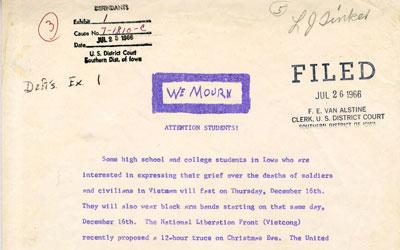
Description
This document was entered as defendants' Exhibit 1 in John F. Tinker et. al. v. The Des Moines Independent Community School District et. al. It describes plans for a peaceful protest against the Vietnam War involving fasting and the wearing of armbands. A…
"Stories from Selma: Rev. Gwendolyn C. Webb," March 2015
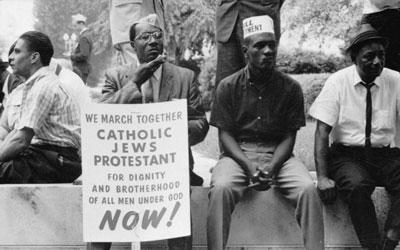
Description
On March 5, 2015, individuals, including Reverend Gwendolyn C. Webb, were invited to the White House on the 50th anniversary of the Selma marches. The Selma to Montgomery marches took place in March 21,1965 and were successfully completed on March 25 to raise awareness for…
Additional Resources:
- "Migration is Beautiful"
This website is a digital humanities project drawn from the holdings of the Mujeres Latinas collections preserved in the Iowa Women's Archives in the University of Iowa Libraries. It highlights the journeys the Latinx community made to Iowa and situates the contributions of Latinx communities within a broader understanding of Iowa's history of migration and civil rights activism. - ACLU - Know Your Rights
The website is the for American Civil Liberties Union. Its content focuses on a "Know Your Rights" section for students, including one's rights in regard to protest. - "Key Moments In The Dakota Access Pipeline Fight" from National Public Radio
The article from National Public Radio is a timeline of activities regarding the Dakota Access Pipeline. Outlined in the article are such moments as its initial proposal to major protests being held in opposition. - "Activist Agriculture" Online Exhibit
The online exhibit from Iowa State University has a number of resources and a concise timeline focusing on agriculture and activism in Iowa. Some of the topics on the website include: the Cow Wars, LULAC and Farmers' Holiday. - "Record of Rights" Online Exhibit
This digital resource from the National Archives is an interactive and expansive collection of records highlighting pursuing the American pursuit to rights through various eras in the country's history. - Teaching for Change: Building Social Justice Starting in the Classroom
Teaching for Change provides teachers and parents with the tools to create schools where students learn to read, write and change the world. By drawing direct connections to real world issues, Teaching for Change encourages teachers and students to question and re-think the world inside and outside their classrooms, build a more equitable, multicultural society and become active global citizens. - Zinn Education Project
The Zinn Education Project promotes and supports the teaching of people's history in classrooms across the country. The website provides free lessons, as well as primary and secondary sources.
Iowa Core Social Studies Standards (9th-12th Grade)
Listed below are the Iowa Core Social Studies content anchor standards that are best reflected in this source set. The content standards applied to this set are high school-age level and encompass the key disciplines that make up social studies for students 9th through 12th grade.
| No. | Standard Description |
| SS.Gov.9-12.13. | Evaluate the powers and responsibilities of local, state, tribal, national, and international civic and political institutions, how they interact and the role of government in maintaining order. (21st century skills) |
| SS.Gov.9-12.19. | Evaluate the effectiveness of political action in changing government and policy, such as voting, debate, contacting officials, campaign contributions, protest, civil disobedience, and any alternative methods to participation. (21st century skills) |
| SS.Gov.9-12.22. | Identify and evaluate the contributions of Iowans who have played a role in promoting civic and democratic principles. (21st century skills) |
| SS.Gov.9-12.24. | Analyze how people use and challenge public policies through formal and informal means with attention to important judicial processes and landmark court cases. (21st century skills) |
| SS.Gov.9-12.26. | Analyze the historical, contemporary, and emerging patterns of political action and activism including voter demographics, party trends over time, polling data, campaign strategies and trends, and alternative means of participating. (21st century skills) |
| SS.Gov.9-12.28. | Identify local and state issues in Iowa and evaluate formal or informal courses of action used to affect policy. |
| SS.Geo.9-12.20. | Assess the impact of economic activities and political decisions on urban, suburban, and rural regions. |
| SS.US.9-12.13. | Analyze how diverse ideologies impacted political and social institutions during eras such as Reconstruction, the Progressive Era, and Civil Rights movement. |
| SS.US.9-12.15. | Assess the impact of individuals and reform movements on changes to civil rights and liberties. (21st century skills) |
| SS.US.9-12.21. | Analyze change, continuity and context across eras and places of study from civil war to modern America. |
| SS.US.9-12.23. | Analyze the relationship between historical sources and the secondary interpretations made from them. |
| SS.US.9-12.25. | Analyze how regional, racial, ethnic and gender perspectives influenced American history and culture. |
| SS.US.9-12.27. | Evaluate Iowans or groups of Iowans who have influenced U.S. History. |